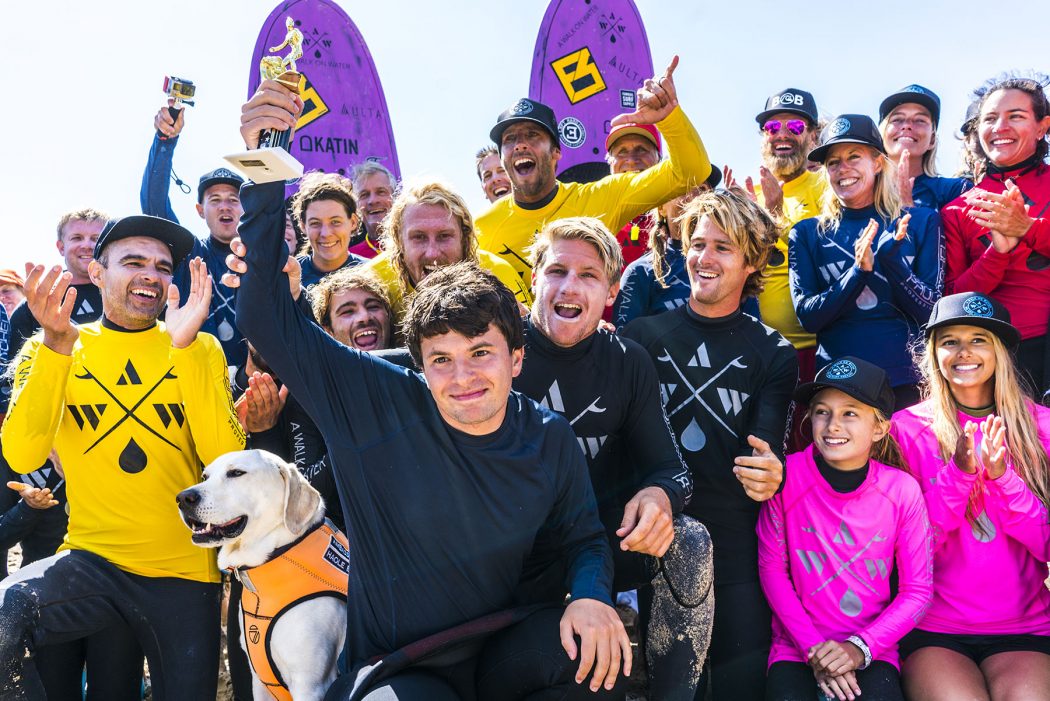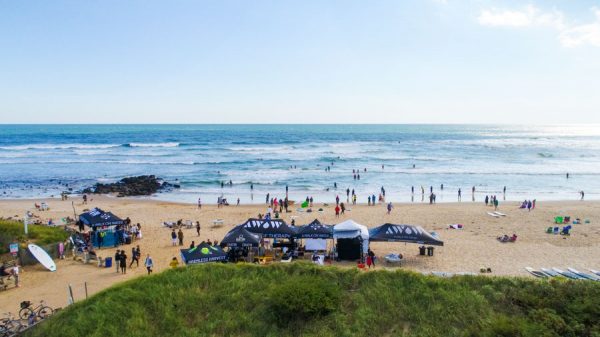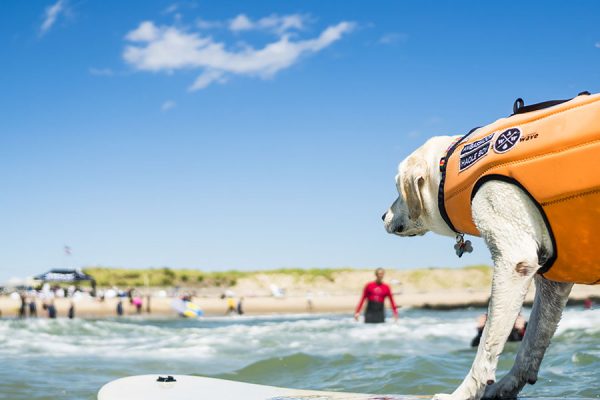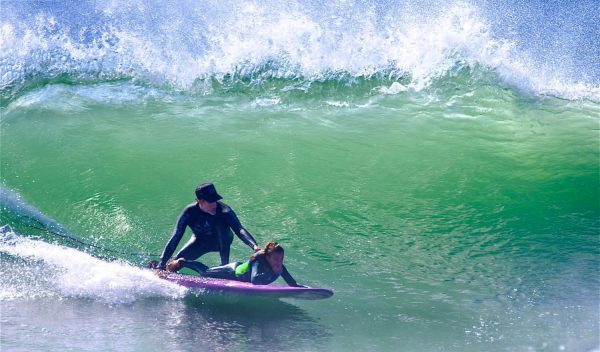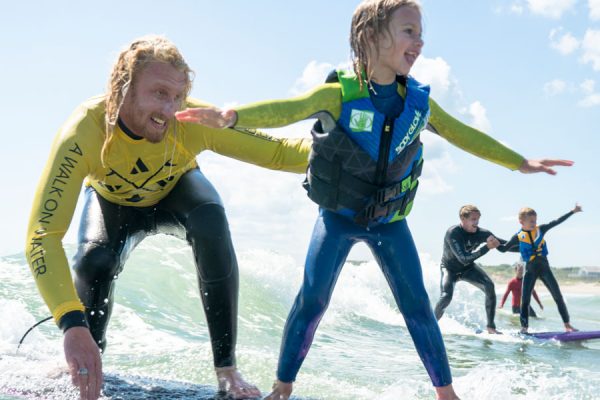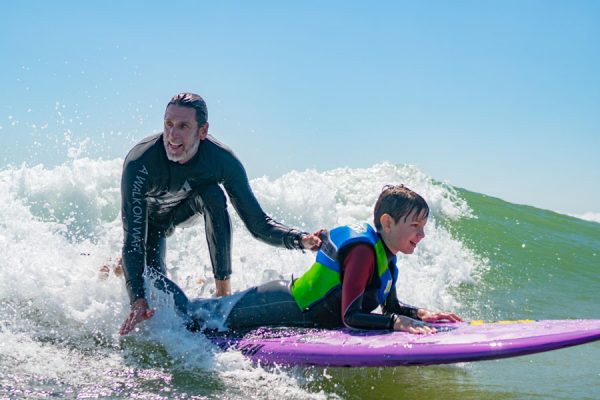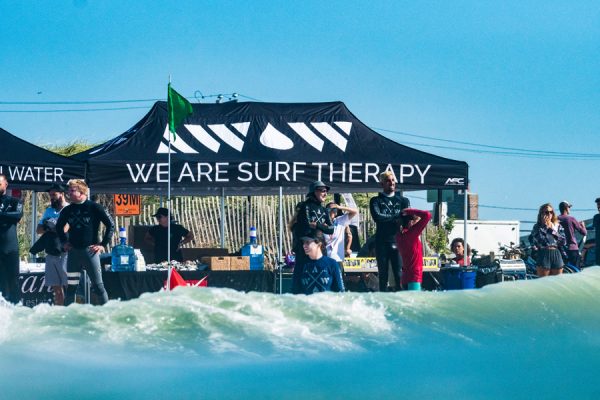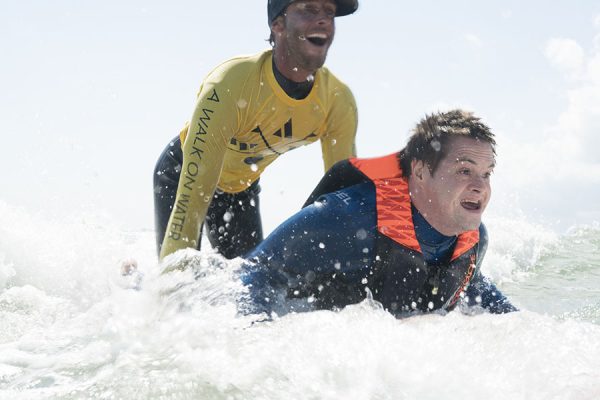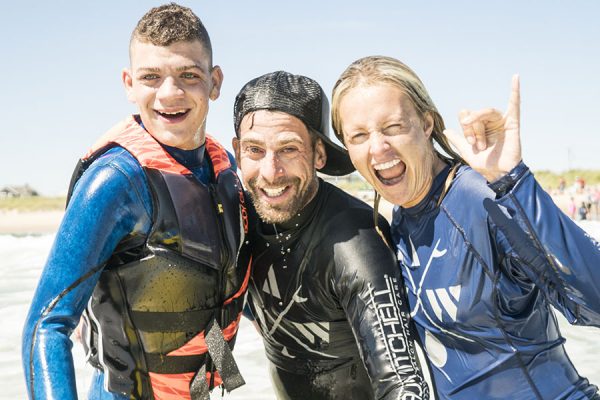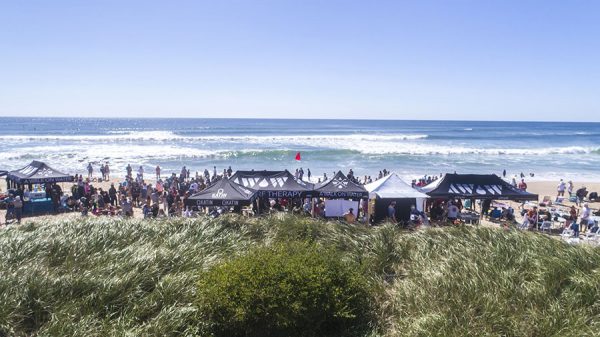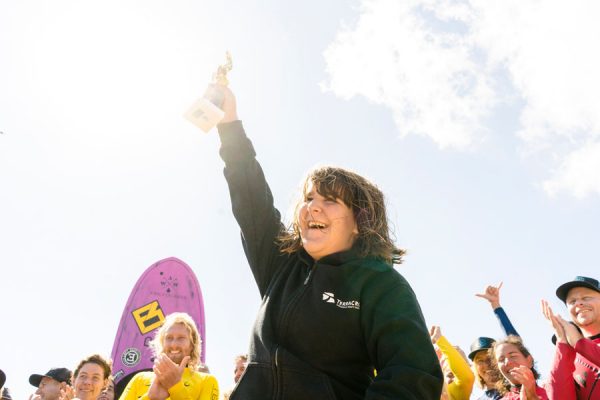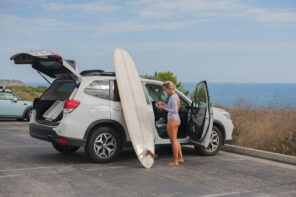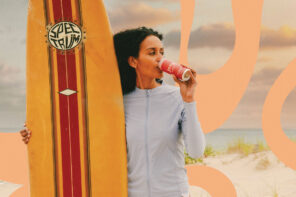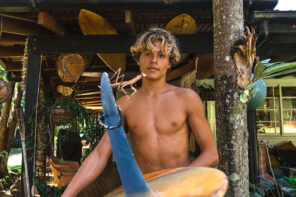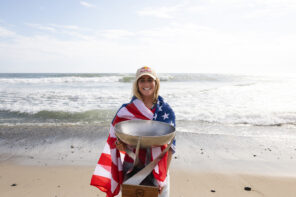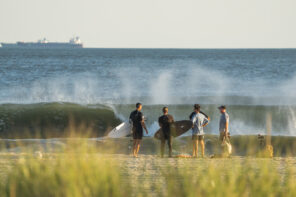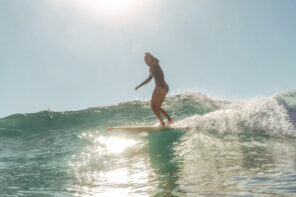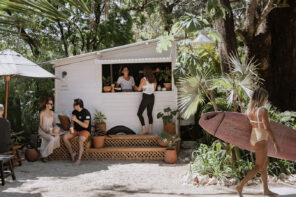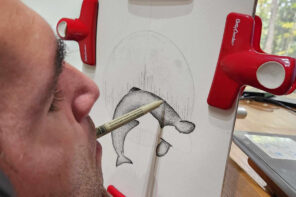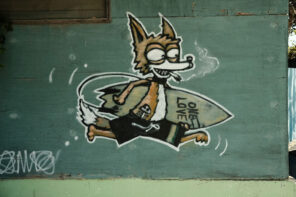I volunteered at the third annual A Walk on Water (AWOW) event in Ditch Plains, Montauk on September 8 and 9th—and finally found something I love more than surfing.
Although often thought of as a selfish sport, it became clear to me during the two-day surf therapy event what plenty of insiders already know—selflessly sharing the stoke of this “sport” is the best way to reach the next level of enjoyment in it.
I began the first day helping one of AWOW’s finest, Denise Olson-Drury, put wetsuits on the athletes. I was nervous. I approached a teenage athlete named Ocean—yes, Ocean!—who stood calmly as other volunteers and I helped struggle her into a wetsuit.
Ocean was unfazed, smiling and staring out at the watery horizon. She then walked a bit awkwardly down the to the water’s edge where she was maneuvered onto a board with an instructor to take her turn walking on water. Minutes later she slid back onto the beach smiling, salty and wanting another go, and I was starting to comprehend what all this was about.
Later on, she had her wetsuit off and was sitting on the beach, so I sat with her and we talked, and I quickly realized that she was just the best ever. A smile crept across her face as she looked out at the waves. And just like that, she was abandoning our riveting conversation to go hustle into another wetsuit. There were only ten minutes left in the morning session, but she wanted just one more wave. This girl is a surfer, I thought. And I loved her even more.
The thing about surf culture, I’m learning, is that just when you think you’ve got it all dialed in and figured out, you find yourself tossed about and then swept up into a new understanding of it. Just like the act of surfing itself. You nail it, you got it—then you fall and get pounded by a set and have to fight your way back to the surface. But once you do, and you have the courage to paddle back out, you understand it, just a little bit more than you did before.
…just when you think you’ve got it all dialed in and figured out, you find yourself tossed about and then swept up into a new understanding of it.
The whole AWOW crew of pure talent and heart pulled off a truly transformative event, for all involved. But more importantly, this family of watermen and women helped to further cement the Montauk community as a surf therapy hub and furthered the empowerment of this movement.
On day two of the event, I found myself high-fiving and cheering till hoarse, as each athlete rode a wave into shore on a big-wave day at Ditch. Team Mascot and Ambassadog, Haole, an 8-year-old yellow lab who surfs better than me, was captivating the attention of each athlete and volunteer as he calmly showed us all how it was done.
The water was white and rough, thanks to Hurricane Irma, but the smiling faces and relaxed body language of the athletes atop the surfboards said it all—the ocean had worked its magic and the experience of riding that wave had done for them what it does for all surfers. Forever changed.
I was fortunate enough, thanks to AWOW Chairman, Laura Rubin, to sit down and talk with charismatic AWOW President and lead surf instructor, Steven “Lippy” Lippman, after the event. In golden hour glow, with the smell of good food and beer, and live music wafting over us on the bench just outside Gig Shack, I got his take on the success of the event here in Montauk. Here are some words, from Lippy, along with a few from East Coast head, Walt Lindveld and New Jersey’s iconic pro surfer Sam Hammer, who volunteered as an instructor at the event:
LdM: Considering the strong surf conditions, how do you feel the last two days went?
Lippy: Well, it’s bittersweet. It’s devastating to watch the news and see and hear people are losing their lives and their homes, and if someone said I had to choose between doing surf therapy or having all of AWOW go save lives, I would choose to go save lives, but the best thing down there right now is to evacuate and hope for the best. And here in Montauk, we were blessed with amazing weather, incredible surf, just fantastic conditions. All the elements came together to bring hundreds and hundreds of incredible passionate human beings together to witness an epic. Saturday was pretty spectacular, and I don’t know if it gets any better than that.
LdM: Can you say a few words about how you feel, personally, about surf therapy?
Lippy: Every surf therapy event is about giving back and making it about the families and their children. It’s so enlightening. On Saturday there were so many emotional moments.
LdM: What are your thoughts on Montauk as a location for this event?
Lippy: The Montauk community by far is one of the most giving, caring, loving people that I’ve had the opportunity to meet and experience. They come together and they just DO! Talk is cheap and this community is about action, not just talk. From The Surf Lodge and Duryea’s to The Montauk Beach House, we have been treated with open arms and feel so welcomed.
LdM: As a California-based entity, how did the East Coast chapter form?
Lippy: Walt Lindveld, our East Coast chapter head, and his son Clash, who has Downs, was our very first connection. I took Clash out three years ago when he was five years old and it was his first time in the ocean, on a board, and I came in from an hour of surfing with him and found myself in a long full group hug with Walt and his extended family, crying, bawling—I was caught off guard. The rad thing about life is that you don’t know what’s going on in each person’s mind, or in their day-to-day grind, and all of a sudden to be able to affect someone in such a positive way that will last with them forever is one of the most humbling things you can ask for.
LdM: Walt, since you happen to be here, can you say a few words about that moment three years ago?
WL: Clash was clinging like a cat in water, freaking out, gripping onto Lippy with the fear of God in him. And today, three years later, he practices his paddling and pop-ups at home. And he goes out to surf with me now, and he’s comfortable.
LdM: That’s so incredible. And can you touch on how you became the East Coast chapter head?
WL: It was an introduction by Laura Rubin that set the wheels in motion. I’m a Montauk resident for the last nine years, a transplant, and my son is in school at Sag Harbor and because of Clash’s experience with “Uncle Lippy” three years ago, I have become so much more involved, and Clash is living proof that surf therapy works.
LdM: That is so incredible, and in your opinion, why does surf therapy work?
WL: It’s about them growing into their skin and overcoming the sensory overload and that carries out through life. That translates to overcoming other fears like sound, which is a common problem. And the words “I’m not scared anymore” are said in our house now. The confidence boost is huge. All these kids go home heroes. The thing is, when we are stressed out and bugging, we connect with the ocean and we find our calm. It’s the same thing for them. The stimuli are different, but they are going into the ocean for the same reasons.
LdM: So Walt, what is on deck for the East Coast chapter?
Walt: We are expanding. We are planning events in North Carolina, New Jersey, Long Beach, and the Rockaways to make it easier to service kids in the city. The more we can share the love, share the stoke, the happier we are.
LdM: Thank you so much, Walt. And Lippy, can you expand on why the surf instructors come back year after year to volunteer?
Lippy: I know all the surf instructors have these moments of giving where all of a sudden the daily headache of traffic and waiting in line at Starbucks that becomes obsolete and you just have this realization, I just affected this family’s life in the most positive way and they are going to remember this moment forever. And it’s something that stays with them forever. And by doing these events year after year with these children and adults with special needs you get to grow with them and see the process. I had a little boy, non-verbal, violent, erratic, punching and screaming, high on the spectrum to “I love you Uncle Lippy” and his first word was “surf” and a lot of the surf instructors have had this experience. And that’s what keeps me and others coming back.
LdM: As a non-profit AWOW is a passion project, a labor of love, an unpaid gig, why do you all do it?
Lippy: It’s one day that we give, and these families live 24/7, 365 days a year, in the realm of frustration, aggravation, and uncertainty. And they would do anything for their children, just as I would do for my own children. They live in a world of questions: Why? How come? How can we help our child? They are doing whatever they can to find aid, education, and support to better their child’s life. AWOW is about providing the family a chance to relax and experience this day at the beach, while we take care of their pride and joy.
We take these children out of their everyday grind to something completely new and stimulating, releasing endorphins. They look forward to it and wait all year for the AWOW Montauk experience. And as a volunteer, it’s not only humbling, but it’s so positive for your soul. It really puts life into perspective, and it definitely makes me appreciate what I have even more. I can’t fathom what these families go through. But as President, and as a volunteer, I have come to know and grow with these families and it’s incredible to see the process and to see the positive growth.
LdM: Just as surfing is an equalizer, surf therapy seems to be an equalizer too. What is the underlying motivation that drives you to funnel so much personal energy into AWOW?
Lippy: I have zero tolerance for any kind of bullying. It makes my blood boil and my eyes roll back in my head like a shark about to bite. And within the AWOW movement, there is zero tolerance for bullies, for judgment. I teach my son to have zero tolerance too. A real human being, a hero, I tell my son, is the person whose heart is kind and gentle and who acts as defender of the victims of bullying, of judgment. And I tell him “you better step up and defend your friend if he’s getting bullied.” It’s the parents’ responsibility to teach that. At an AWOW event, no matter what we are up against, each athlete is treated equally and with open arms.
A real human being, a hero, I tell my son, is the person whose heart is kind and gentle and who acts as defender of the victims of bullying, of judgment.
LdM: How was AWOW born?
Lippy: AWOW is a movement and a concept of going above and beyond for others less fortunate than yourself. We don’t claim to be the best or to be the original surf therapy. There is really great surf therapy out there, like Life Rolls On, with Jesse Billauer, and Surfers Healing, and Mauli Ola Foundation and have donated my time as a surf instructor, and have nothing but the utmost respect for all of them.
Around six years ago, I met with Pat Notaro who brainchild-ed the idea of starting a surf therapy non-profit organization called ‘A Walk on Water’ that would give to all in need. So Pat assembled a team of people that he thought could bring a lot to the table in order to make this dream come to life. So he brought in individuals like Sean Swentek, Jason Logan, Matt Noble, Jason Wolk, and myself. We all worked very hard to make this success happen. And each event has seen exponential growth. And we have added new players—Ari Markow, Jeff “Swampy” Marsh and Laura Rubin—who are now a dynamic part of the dream team.
LdM: Tell us a little about the safety precautions you use during these events.
Lippy: We really care about safety and about how the families feel throughout the day. Everything is in place, just in case—everything from the best waterman in the world as lifeguards and surf instructors to making sure the beach volunteers understand what their role is and how important it is. We don’t mess around. We take it all very seriously. Every little element makes AWOW what it is. It’s about the incredible families that come back for more and about all the volunteers.
LdM: What’s on the horizon for AWOW?
Lippy: We have our next event in Huntington Beach on October 7th and then in First Point, Malibu on November 4th. We’d love to see everyone there.
We want to grow the East coast chapter and the Montauk vibe and have everyone take on roles to put it together. We’ve supplied Montauk with a complete setup that we are leaving here so that they can be self-sufficient. We are planning to increase to two events, June and September, in Montauk for 2018. We have Oahu’s North shore, Costa Rica and Cabo San Lucas on our radar. But above all else, we are about doing things the right way—baby steps. We want to make sure that the events we put on are safe and memorable.
LdM: Any last thoughts?
Lippy: Yes, AWOW is about empowering the community to come together and go above and beyond. We truly want to help them feel proud of their surroundings and their children. We introduce them to the invigorating chemistry and incredible healing effects of the ocean. And here at the end of the world, blessed with such an abundance of this natural resource, it’s just the perfect place to shine a light and create all new opportunities.
AWOW was so fortunate to have Sam Hammer in attendance, and when I spoke with him just after the event, he had this to say:
LdM: Sam, as a first-time AWOW volunteer how was this event experience for you?
SH: I have volunteered with other charities for the same cause but I felt that this event was run so smoothly and there was no shortage of help. It was really an amazing experience and I was grateful and glad to be a part of it.
LdM: How was your experience with the athletes in the water?
SH: The conditions were a little rough, there was a little too much swell but it all went so smoothly with no issues. I had great athletes to work with. My last athlete of the day was an 80-year old blind woman and it was mind-blowing. Her words were so touching and it was really awesome.
LdM: Can you say a word or two on why you think surf therapy works?
SH: There’s that calming effect that the ocean provides. There’s anxiety going into it, but if you let it slow down, it really is a peaceful place and I think that is what they are experiencing. It’s amazing to see how they are on the beach, but then they get in the water, and I don’t know what happens but something settles in and they calm down and smile—just a different person.
LdM: Sam, thanks so much for sharing your experience, will you come back?
SH: Most definitely. It feels good to do things of that nature and to share surfing, which has been my whole life and livelihood…you want to share that with people.
Walt had told the volunteers on our first morning, “Ain’t no man, man enough, not to cry here,” and I diligently wrote it down, because it sounded powerful. But then I stood at the afternoon awards ceremony on the second day, as Ocean received her gold trophy and hugged it to her chest while her other hand was clasped in a fist of victory and power. And there I was, crying, and finally, understanding.

